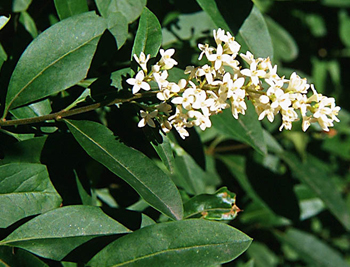Contents:
Common Names | Parts Usually Used | Plant(s) & Culture | Where Found | Medicinal Properties | Biochemical Information
Legends, Myths and Stories | Uses | Formulas or Dosages | Warning | Bibliography
Scientific Names

- Ligustrum vulgare L.
- Ligustrum lucidum
- Oleaceae
- Olive family
Common Names
- Prim
- Primwort
- Privy
Parts Usually Used
Leaves, bark
Back to Top
Description of Plant(s) and Culture
Privet is a deciduous shrub; grows to 15 feet in the natural state, the stems bear dark green, opposite, oblong-ovate to lanceolate leaves 1 or 2 inches long and about 1/2 as wide. The small, white, funnelform flowers grow in dense, pyramidal panicles during June and July. The fruit is a shiny black berry.
Back to Top
Where Found
Grows wild in southern Europe, northern Africa, and western Asia and is commonly cultivated as a hedge plant in parks and gardens in North America.
Back to Top
Medicinal Properties
Astringent, bitter
Back to Top
Biochemical Information
Oleanolic, palmitic, linoleic and ursolic acids, mannitol and glucose, starch, bitter resin, bitter extractive, albumen, salts, and a peculiar substance called ligustrin
Back to Top
Legends, Myths and Stories
The genus Ligustrum, of the olive family (Oleaceae) comprises approximately 50 species.
Back to Top
Uses
A decoction of leaves or bark is helpful for diarrhea, chronic bowel problems, and as a vaginal douche, mouthwash or gargle, a wash for skin problems, and its bitter properties make the tea useful for improving appetite and digestion.
Back to Top
Formulas or Dosages
Decoction: boil 1 tsp. leaves or bark in 1 cup water. Take 1 to 2 cups a day.
Back to Top
Warning
The berries are poisonous; children have died from eating them.
Back to Top
Bibliography
![]() American Folk Medicine
American Folk Medicine, by Clarence Meyer, Meyerbooks, publisher, PO Box 427, Glenwood, Illinois 60425, 1973
![]() Culpeper’s Complete Herbal & English Physician: Updated With 117 Modern Herbs
Culpeper’s Complete Herbal & English Physician: Updated With 117 Modern Herbs, by Nicholas Culpeper, Meyerbooks, publisher, PO Box 427, Glenwood, Illinois 60425, 1990, (reprint of 1814)
![]() The Herb Book
The Herb Book, by John Lust, Bantam Books, 666 Fifth Avenue, New York, NY. copyright 1974.
![]() Indian Herbalogy of North America
Indian Herbalogy of North America, by Alma R. Hutchens, Shambala Publications, Inc., Horticultural Hall, 300 Massachusetts Avenue, Boston, Massachusetts 02115, 1973
![]() Planetary Herbology
Planetary Herbology, by Michael Tierra, C.A., N.D., O.M.D., Lotus Press, PO Box 325, Twin Lakes. WI 53181., Copyright 1988, published 1992
![]() Webster’s New World Dictionary
Webster’s New World Dictionary, Third College Edition, Victoria Neufeldt, Editor in Chief, New World Dictionaries: A Division of Simon & Schuster, Inc., 15 Columbus Circle, New York, NY 10023
 The Rodale Herb Book: How to Use, Grow, and Buy Nature’s Miracle Plants (An Organic gardening and farming book)
The Rodale Herb Book: How to Use, Grow, and Buy Nature’s Miracle Plants (An Organic gardening and farming book), edited by William H. Hylton, Rodale Press, Inc. Emmaus, PA, 18049., 1974
